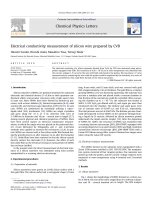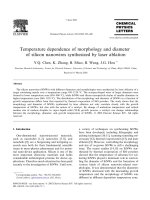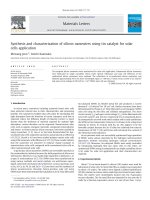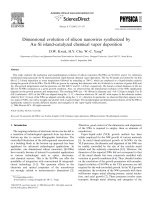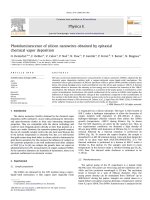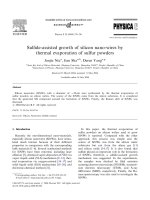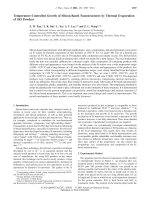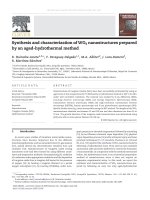Advanced numerical characterization of silicon with defect by nanoindentation
Bạn đang xem bản rút gọn của tài liệu. Xem và tải ngay bản đầy đủ của tài liệu tại đây (4.41 MB, 101 trang )
Queensland University of Technology
Brisbane Australia
Advanced Numerical Characterization of Silicon with
Defect by Nanoindentation
Qiang Fu
Principal Supervisor: Associate Professor Yuantong Gu
Associate Supervisor: Associate Professor Cheng Yan
A thesis submitted in fulfilment of the requirements for the degree of master of engineering
Faculty of Science and Engineering
Queensland University of Technology
Jan 2012
Advanced Numerical Characterization of Silicon with Defects by Nanoindentation
Acknowledgement
I
The author of this thesis would like to take this opportunity to acknowledge those who
have offered their assistance and support during the research.
Firstly, the author would sincerely express his gratitude to his principal and associate
supervisor, Professors Yuantong Gu and Cheng Yan, for the guidance, advice, patience and
encouragement. Without their knowledge, vision and support, this work would not have
been possible.
Secondly, the author would express his appreciation to the QUT High Performance
Computing & Research Support Team. With their help, the massive computational
simulations have been completed efficiently. Special thanks extended to Mr. Haifei Zhan,
for the knowledge of the MD simulation field.
At last but not least, the author would thanks to his beloved family for their always support
and encouragement throughout the completion of this work and his life.
Queensland University of Technology
Advanced Numerical Characterization of Silicon with Defects by Nanoindentation
Publication
II
During the course of this project, one journal paper has been accepted. It is listed below
for reference.
Fu. Q, Zhan. HF and Gu. YT Atomistic investigations of single-crystal silicon with preexisting defect. Accepted by Advanced Science Letters in 2011.
Queensland University of Technology
Advanced Numerical Characterization of Silicon with Defects by Nanoindentation
Abstract
III
Nano silicon is widely used as the essential element of complementary metal oxide
semiconductor (CMOS) and solar cells. It is recognized that today, large portion of world
economy is built on electronics products and related services. Due to the accessible fossil
fuel running out quickly, there are increasing numbers of researches on the nano silicon
solar cells.
The further improvement of higher performance nano silicon components requires
characterizing the material properties of nano silicon. Specially, when the manufacturing
process scales down to the nano level, the advanced components become more and more
sensitive to the various defects induced by the manufacturing process.
It is known that defects in mono-crystalline silicon have significant influence on its
properties under nanoindentation. However, the cost involved in the practical
nanoindentation as well as the complexity of preparing the specimen with controlled
defects slow down the further research on mechanical characterization of defected silicon
by experiment. Therefore, in current study, the molecular dynamics (MD) simulations are
employed to investigate the mono-crystalline silicon properties with different pre-existing
defects, especially cavities, under nanoindentation.
Parametric studies including specimen size and loading rate, are firstly conducted to
optimize computational efficiency. The optimized testing parameters are utilized for all
simulation in defects study. Based on the validated model, different pre-existing defects
are introduced to the silicon substrate, and then a group of nanoindentation simulations of
these defected substrates are carried out. The simulation results are carefully investigated
and compared with the perfect Silicon substrate which used as benchmark.
Queensland University of Technology
Advanced Numerical Characterization of Silicon with Defects by Nanoindentation
It is found that pre-existing cavities in the silicon substrate obviously influence the
mechanical properties. Furthermore, pre-existing cavities can absorb part of the strain
energy during loading, and then release during unloading, which possibly causes less
plastic deformation to the substrate. However, when the pre-existing cavities is close
enough to the deformation zone or big enough to exceed the bearable stress of the crystal
structure around the spherical cavity, the larger plastic deformation occurs which leads the
collapse of the structure. Meanwhile, the influence exerted on the mechanical properties
of silicon substrate depends on the location and size of the cavity. Substrate with larger
cavity size or closer cavity position to the top surface, usually exhibits larger reduction on
Y
.
Queensland University of Technology
IV
Advanced Numerical Characterization of Silicon with Defects by Nanoindentation
Certification of Thesis
V
I hereby declare that no part of this work has previously been accepted for the award of
any other person in any university or institute. This thesis was completed during my
enrolment for degree of master by research at Queensland University of Technology, and
to the best of my knowledge the material presented is original except where due reference
is made in the text of this thesis.
Qiang Fu
Queensland University of Technology
Advanced Numerical Characterization of Silicon with Defects by Nanoindentation
Table of Contents
1
1 Chapter 1 Introduction....................................................................................................................... 8
1.1
Background ........................................................................................................................... 8
1.2
Current Research of Nano Silicon .......................................................................................... 9
1.3
Objective............................................................................................................................. 10
1.4
Scope .................................................................................................................................. 12
1.5
Structure of Thesis .............................................................................................................. 13
2 Chapter 2 Literature Review............................................................................................................. 14
2.1
Nanoindentation ................................................................................................................. 14
2.1.1
Y
2.1.2
Hardness ...................................................................................................................... 16
2.1.3
Other Mechanical Properties ........................................................................................ 17
2.2
M
.......................................................................................................... 16
2.1.3.1
Strain-Rate Sensitivity ........................................................................................... 17
2.1.3.2
Activation Volume ................................................................................................. 18
Contact Mechanics .............................................................................................................. 18
2.2.1
Hertz Contact Theory .................................................................................................... 18
2.2.2
Oliver and Pharr method .............................................................................................. 21
2.2.3
Comments .................................................................................................................... 23
2.3
Methodology Review .......................................................................................................... 23
2.3.1
FEM Models ................................................................................................................. 24
Queensland University of Technology
Advanced Numerical Characterization of Silicon with Defects by Nanoindentation
2.3.2
Molecular Dynamics ..................................................................................................... 24
2.3.3
Multi-scale Method ...................................................................................................... 26
2.3.4
Discussion .................................................................................................................... 27
2
2.4
Review of Molecular Dynamic ............................................................................................. 27
2.4.1
Initial Condition ............................................................................................................ 28
2.4.2
Interatomic Potentials .................................................................................................. 29
2.4.2.1
Pair Potential ........................................................................................................ 29
2.4.2.1.1 Lennard-Jones potential (L-J) ............................................................................. 29
2.4.2.1.2 Born Lande potential........................................................................................ 30
2.4.2.1.3 Morse potential and Johnson potential .............................................................. 30
2.4.2.1.4 Tersoff potential ................................................................................................ 31
2.4.2.2
Multi-body Potential ............................................................................................. 31
2.4.2.2.1 Embedded Atom Method (EAM) ........................................................................ 32
2.4.2.2.2 Stillinger-Weber (SW) Multiple-Body Potential................................................... 33
2.4.3
Integration Algorithms.................................................................................................. 33
2.4.4
Molecular Dynamics in Different Ensembles / Temperature conversion ........................ 34
2.5
Phase Transformation of Silicon .......................................................................................... 34
3 Chapter 3 Characterization of Mono-crystalline silicon and Parametric Study .................................. 36
3.1
Numerical Implementation ................................................................................................. 36
3.2
Interatomic potentials ......................................................................................................... 37
3.3
Loading-Displacement Curve ............................................................................................... 40
Queensland University of Technology
Advanced Numerical Characterization of Silicon with Defects by Nanoindentation
3.4
Results of indentation of the perfect substrate.................................................................... 43
3.5
Parametric Studies of Specimen Size and Loading Rate........................................................ 44
3
3.5.1
The influence of substrate lateral size ........................................................................... 45
3.5.2
The influence of Substrate Thickness ............................................................................ 49
3.5.3
The Influence of Loading Rate....................................................................................... 52
3.6
Conclusion .......................................................................................................................... 54
4 Chapter 4 Characterization of Mono-crystalline Silicon with Defects ................................................ 57
4.1
Computational Model and Defects Description ................................................................... 58
4.2
Effect of the Cavity Size ....................................................................................................... 59
4.2.1
Description of Defect Cases........................................................................................... 59
4.2.2
Load-Displacement Curve and Test Results ................................................................... 59
4.2.3
Phase Transformation and Atomic Configuration .......................................................... 62
4.2.4
Discussion..................................................................................................................... 65
4.3
E
.................................................................................................. 70
4.3.1
Description of Defect Cases........................................................................................... 70
4.3.2
Load-Displacement Curve and Test Results ................................................................... 71
4.3.3
Phase Transformation and Atomic Configuration .......................................................... 74
4.3.4
Discussion..................................................................................................................... 77
4.4
Effect of multiple cavities .................................................................................................... 80
4.4.1
Description of Defect Cases........................................................................................... 80
4.4.2
Load-Displacement Curve and Test Results ................................................................... 81
Queensland University of Technology
Advanced Numerical Characterization of Silicon with Defects by Nanoindentation
4.4.3
Phase Transformation and Atomic Configuration .......................................................... 82
4.4.4
Discussion..................................................................................................................... 83
4
5 Chapter 5 Conclusion and Future Work ............................................................................................ 86
5.1
Conclusions ......................................................................................................................... 86
5.2
Recommended Future Work ............................................................................................... 89
6 Bibliography..................................................................................................................................... 90
Queensland University of Technology
Advanced Numerical Characterization of Silicon with Defects by Nanoindentation
Table List
5
Table 1 Equations to determine the load P for different indenters [28] ................................................. 20
Table 2 Parameters in Tersoff Potential for silicon .............................................................................. 39
Table 3 Parameter in the Morse potential for Interaction of C-Si ......................................................... 40
Table 4 Loading force at maximum indentation depth for different lateral size .................................... 46
Table 5 Young’s modulus and hardness for different lateral size substrate........................................... 46
Table 6 Loading force at maximum indentation depth for different thickness ...................................... 50
Table 7 Young’s Modulus and Hardness for different lateral size substrate ......................................... 50
Table 8 Group d Defect Cases ............................................................................................................ 59
Table 9 Loading force at maximum penetration depth for Group d ...................................................... 60
Table 10 Estimated Young’s modulus and hardness for Group d ........................................................ 62
Table 11 Coordination Number for All Single Cavity Cases................................................................ 66
Table 12 Group f Defect Cases ........................................................................................................... 70
Table 13 Estimated Young’s modulus and hardness for cases f1- f4 in Group f ................................... 73
Table 14 Estimated Young’s modulus and hardness in Group f ........................................................... 74
Table 15 Estimated Young’s modulus and hardness for Group e ......................................................... 82
Queensland University of Technology
Advanced Numerical Characterization of Silicon with Defects by Nanoindentation
Figure list
6
Figure 1 A representation of the h-P (displacement vs. force) diagram [26] ......................................... 15
Figure 2 (a) Geometry of loading a preformed impression of radius R r with a rigid indenter radius Ri.(b)
Compliance curve (load vs. displacement) for an elastic-plastic specimen loaded with a spherical
indenter showing both loading and unloading responses. Reprinted from [21] .................................... 21
Figure 3 Time and space scale of modern numerical methods and their applications [42]. ................... 25
Figure 4 Phase I silicon gradually transformed into Phase II silicon under indentation stress [55]. ....... 35
Figure 5 (a) Nanoindentation simulation model; (b) Schematic of cavities’ positions. ......................... 37
Figure 6 Loading –Displacement curve for prefect case ...................................................................... 41
Figure 7 Potential- Distance Curve plot in according the Morse potential used in the simulation model
........................................................................................................................................................... 42
Figure 8 Loading –Displacement curve for five lateral sizes................................................................ 45
Figure 9 (a) Hardness and (b) Young’s modulus – lateral size curves for five lateral sizes ................... 48
Figure 10 Loading –Displacement curve for four thicknesses 22a, 18a, 14a and 10a. .......................... 49
Figure 11 Trend curve for hardness of substrates with four different thicknesses. ................................ 51
Figure 12 Load – Displacement curve for five different loading rates ................................................. 53
Figure 13 Young’s modulus quickly converges with the decrease of the speed .................................... 54
Figure 14 Coordinate system for defining the location of defects ........................................................ 58
Figure 15 Load-displacement curves of Group d. ................................................................................ 61
Figure 16 Atomic configurations of d0 case at four different stages: (a) - (d): substrate with1.5a radius
defect at the indentation depth of 0.657 nm, 1.857 nm, unloading to depth 0.657nm and full unloaded;
Atoms with the CN value between 0 and 13 are visualised. ................................................................. 63
Queensland University of Technology
Advanced Numerical Characterization of Silicon with Defects by Nanoindentation
Figure 17 Atomic configurations of case d3 at four different stages. (a) - (d): substrate with1.5a radius
defect at the indentation depth of 0.657 nm, 1.857 nm, unloading to depth 0.657nm and full unloaded;
Atoms with the CN value between 0 and 13 are visualised. ................................................................. 64
Figure 18 Number of atoms with specified CNs (6, 7 and 8) versus time: (a) case d0; (b) case d3; (c)
case d4; (d) case d5; and (e) case d6. .................................................................................................. 69
Figure 19 .Load-displacement curves of Group f: (a) Offset in –y direction; (b) Offset in –z and +z
directions............................................................................................................................................ 72
Figure 20 Atomic configurations of cases f3 and f6 at three different stages: (a1)-(d1): case f3 at the
indentation depth of 0.657 nm, 1.857 nm, 0.657 nm unloading and full unloaded; (a2)-(d2): case f6 at
the indentation depth of 0.657 nm, 1.857 nm, 0.657 nm unloading and full unloaded. Atoms with the
CN value between 0 and 13 are visualised. ......................................................................................... 75
Figure 21 Atomic configurations of cases f1 and f4 at three different stages: (a1)-(d1): case f1 at the
indentation depth of 0.657 nm, 1.857 nm, 0.657 nm unloading and full unloaded; (a2)-(d2): case f4 at
the indentation depth of 0.657 nm, 1.857 nm and full unloaded. Atoms with the CN value between 0
and 13 are visualised. ......................................................................................................................... 77
Figure 22 Number of atoms with specified CNs (6, 7 and 8) versus time: (a) case f3; (b) case f6. ........ 79
Figure 23 Group e: Four cavities cases (a) Top view (b) Isometric view .............................................. 80
Figure 24 Load-displacement curves of Group e, 4 cavities with the radii of 0.5a, 1a, 1.5a and 2a,
respectively. ....................................................................................................................................... 81
Figure 25 Atomic configurations of cases e1 and e4 at two different stages: (a1)-(a4) at the indentation
depth of 1.857 nm; (b1)-(b4) full unloaded; Atoms with the CN value between 0 and 13 are visualised.
........................................................................................................................................................... 83
Figure 26 Number of atoms with specified CNs (6,7 and 8) versus time for case e1. ........................... 84
Figure 27 Number of atoms with specified CNs (6, 7 and 8) versus time for case e4 ........................... 85
Queensland University of Technology
7
Advanced Numerical Characterization of Silicon with Defects by Nanoindentation
1 Chapter 1 Introduction
8
1.1 Background
In the field of nano-material research, silicon (Si) is one of the most widely researched
substrates. It is recognized that today, 16% of the world economy is built on electronics
products and related services [1, 2]: communication, computing, consumer electronics,
health, transport, security, and environment, etc. This percentage is growing every year. As
the essential element of complementary metal oxide semiconductor(CMOS), silicon is used
for microprocessors, microcontrollers, static RAM, and other digital logic circuits. Within
next 15 years, the critical feature size of the elementary nano-electronic devices will drop
from 25nm in 2007 to 4.5nm in 2022 [2, 3]. Within the foreseeable further, silicon will
maintain its position as the main semiconductor material. The further improvement for
higher performance and low/ultra low power application generates the needs on the new
material, technologies and device architectures. According to the vision of SINANO
institute (a nano-electronic research net work based on Europe), several future CMOS
developments are expected [1, 2]:
Advancing core technology for CMOS ;
Adding functionality to CMOS;
Characterisation at the nano-scale; and etc.
In the coming decades, the core technology for CMOS will continuously scale down the size
of silicon based device to nano level. The lifetime of the devices will likely be extended as
the maximum benefit is derived from a particular set of device dimensions. Smaller
devices enable the possibility of parallel computing in multi-core processors, rather than by
increasing absolute clock frequency, which will be limited to about 4 GHz constrained by
Queensland University of Technology
Advanced Numerical Characterization of Silicon with Defects by Nanoindentation
cooling limits. The smaller scale of CMOS is the prerequisite to allow adding the
functionality to CMOS. The additional architectures need to integrate nanostructures in
electronic substrates, e.g. nanopores, nanogaps, nanorods, nanotubes, nanowire,
nanocrystals and etc [1, 2].
Another important application of mono-crystalline silicon is for solar cells. Solar energy has
the potential to become the primary energy supplying global need. The production of solar
cell system increased 30% to 35% in past 10 years. The power generated by solar cell
systems reached about 1.7GW in 2007 [3, 4]. The thin-film technologies have significant
contribution to the improvement of solar cells. The nanostructured silicon thin-film solar
cell lower manufacturing costs by reducing the amount of materials required in creating
the active material for solar cells. From technical perspective, the thin-film structure
strongly enhances the light trapping of the solar cells. Furthermore, the plan to produce
more efficient solar cells with nanowire silicon has been introduced. The potential
advantage of the nanowire silicon solar cells over the thin-film solar cells include reduced
reflection, enhanced light trapping, band gap tuning, and silicon compatible. Due to the
accessible fossil fuel running out quickly, there are increasing numbers of researches on
the property of nano silicon by experiment and simulation[4].
It is clear that silicon will be a significant material for the further technology development.
However the size of silicon components is scaled down to nano level, it is crucial to have a
comprehensive understanding of nano silicon properties.
1.2 Current Research of Nano Silicon
In order to bridge the gap between the theoretical concepts and the design of nano-scale
silicon components, the study focus is on characterizing the material properties, i.e. the
Queensland University of Technology
9
Advanced Numerical Characterization of Silicon with Defects by Nanoindentation
strength of components needs to be investigated and designed to boost the carrier mobility.
As the manufacturing process scales down to the nano level, the advanced devices will be
more and more sensitive to the various defects induced by the manufacturing process.
Therefore, a fundamental understanding of silicon properties and deformation processes is
crucial for its application and manufacturing purpose. Various experimental approaches
such as nanoscratch and nanoindentation are traditionally employed to exploit the
characteristics of nano-scale silicon. As one of the mature techniques to investigate
mechanical properties of a material, nanoindentation has been extensively employed to
explore mechanical properties of single-crystal silicon for more than a decade [5, 6]. For
instance, Domnich et al. [7]
-Si (Si-II) phase is formed in a high-stress region
and the structure becomes amorphous after unloading. Besides of the experimental
studies, affluent atomistic investigations have also been carried out to interpret the
deformation mechanisms of single-crystal Si under nanoindentation [8, 9]. Zhang and his
group members [10-13] have conducted a serial of molecular dynamics (MD) studies of
single-crystal silicon under nanoindentation. Several important results have been
concluded, e.g., Si-I
-Si (Si-II) phase when loading is
large enough to cause plastic deformation, and may further convert into an amorphous
phase during unloading.
1.3 Objective
It is known that materials used in production always contain defects, such as point defects,
cavities (vacancies), impurities et, al. [14, 15]. Such nano-scale defects are one of the most
important factors that affect
F
ed
pits (COPs) on the polished surface of the silicon wafer are reported degrading gate oxide
quality[16]. However, the experimental research on the nano material is constrained by
Queensland University of Technology
10
Advanced Numerical Characterization of Silicon with Defects by Nanoindentation
time and funding. Nano-scale experiment has to be in the controlled environment, factors
such as temperature, humanity, vibration as well as the preparation of the sample could
have significant influence on the results of experiments. Particularly, as the research is
based on such a small scale, the nano defects become one of important factor which could
affect the results. It is no doubt that physical preparation of the specimen with controlled
defects is extremely hard. Therefore, to experimentally characterize the influence from
defect is even more difficult. Only a few studies are found in regard to defects studies, e.g.,
Ciszek and Wang [17] employed the float-zone (FZ) method to study the defect and
impurity effect on the material properties of minority charge carrier lifetime and
photovoltaic efficiency. Under such circumstances, researchers refocused to the numerical
methods, including ab initio calculations [18] and molecular dynamics (MD) simulations.
Particularly, the molecular dynamics (MD) simulation, not only has the ability to precisely
control and alter the defects within specimen, but also has the ability to provide in-time
deformation insights. It becomes a
For instance, Sinno et al. [19] used MD to estimate the equilibrium and transport
properties of self-interstitials and vacancies in crystalline silicon at high temperatures. It is
seen that, although the perfect single-crystal silicon is well studied by previous researchers,
the study of d
silicon mechanical properties is still rare.
Therefore, the aim of this project is to use numerical tool to investigate and explore the
defects influences on silicon material properties. Therefore, a set of specific objectives are
achieved in this research. Firstly, a numerical nanoindentation model (molecular dynamics)
is developed. Then the reliability and effectiveness of the simulation techniques is verified.
In this thesis, parametric studies of the geometric size of the specimen (lateral size and
thickness) and the loading rate are conducted to optimize the simulation model. Basing on
the validated model, different pre-existing defects are introduced to the silicon substrate,
and then a group of nanoindentation simulations of these defected substrates are carried
Queensland University of Technology
11
Advanced Numerical Characterization of Silicon with Defects by Nanoindentation
out. The simulation results are carefully investigated and compared with the results from
12
the benchmarking model of perfect silicon substrate.
1.4 Scope
In this project, molecular dynamics (MD) simulations are carried out to reproduce the
mono-crystalline silicon nanoindentation experiment with a rigid hemispherical indenter.
The simulations produce load-displacement curves and hence mechanical properties, e.g.
Young s modulus and hardness can be determined. The model is validated by comparing
the calculated Young s modulus and hardness with the results reported in referred
literatures.
In addition, the simulations are further performed by varying main parameters to optimize
the computational efficiency and simulation accuracy. The influences of parameters to the
calculated results are analyzed and then the acceptable test parameters are selected for
further studies. The tendencies of the influence are checked against the similar cases
investigated by other researchers to provide supportive evidence of model validation.
The cases of mono-crystalline silicon with single cavity and multiple cavities are both
investigated. In order to systematically investigate the influence from single to multiple
cavities, the defect cases are divided into three groups. For the first group, the centers of
spherical cavities are coincident with the substrate lateral center, while the radius of the
cavities varied from case to case. There are two parts of research in second group. For one
part of research, the positions of cavities with the same size remain unchanged on
thickness direction, but gradually moved away from the substrate lateral center. In another
part of research, the cavities positions are always on substrate lateral center, and moved in
the thickness direction. In the third group, simple multi-cavities cases are investigated.
Queensland University of Technology
Advanced Numerical Characterization of Silicon with Defects by Nanoindentation
The load-displacement curves and calculated mechanical properties are compared and
analyzed. The preliminary conclusions are drawn based on the tendency of loading force,
Y
modulus and hardness. Furthermore, the number of silicon atoms with coordinate
number (CN) of six, seven and eight are monitored during loading-unloading process. The
influences of the pre-existing cavity defects to the mono-crystalline silicon phase
transformation are discussed and the visualized atomic configurations are presented to
assist with explaining the phenomena.
1.5 Structure of Thesis
The thesis is organized as following. Chapter 1 introduces the current research of the nano
Silicon, and outlines the objective and the scope of this thesis. In the chapter 2, the
technical components involved in the nanoindentation are reviewed. Additionally, an
overview of numerical simulation methods as well as the MD simulation is included in this
chapter is included.
In chapter 3, we developed and validated the MD simulation model for the
nanoindentation. The parametric studies were carried out to optimize the MD simulation
model.
In chapter 4, we utilized the optimized model to characterize the Si with defects. The cases
with single cavity of different sizes and locations are investigated. Cases with certain
multiple cavities are also considered.
Finally, the conclusion and the further work are discussed in chapter 5.
Queensland University of Technology
13
Advanced Numerical Characterization of Silicon with Defects by Nanoindentation
2 Chapter 2 Literature Review
14
In this chapter, the technical components including the nanoindentation, contact
mechanics and silicon mechanical properties are reviewed. Additionally, an overview of
numerical simulation methods is included, and particular attentions are paid to the MD
simulation, which is believed to be the most suitable method to investigate the silicon
properties with available resources.
2.1 Nanoindentation
Nanoindentation is one of mature techniques to investigate nano-scale material s
properties. It uses the recorded depth of the indenter into the specimen along with the
measured applied load to determine the area of contact and hence the material
mechanical properties. The load applied to the indenter increased from zero to the
maximum and then reduced from maximum to zero, which is usually termed as loading
and unloading. During this process, usually both elastic and plastic deformations are
involved. Due to the plastic deformation, a residual impression is left on the surface of the
testing substrate. The results of nanoindentation rely on the accurate determination of the
initial contact of the indenter with the specimen surface, corrections for any penetration
that arises during this initial contact, corrections for compliance of the loading column,
corrections for the departure of ideal shape of the indenter, and corrections for materialsrelated issues such as piling-up and indentation size-effect, residual stress, etc [20].
However, the nano-scale residual impression cannot be accurately measured by
conventional method. Using elastic equation of Hertz contact, the area of contact can be
Queensland University of Technology
Advanced Numerical Characterization of Silicon with Defects by Nanoindentation
estimated from the depth of penetration and the geometry of the indenter, and obtain the
Young s modulus and hardness from the unloading curve [21]. Oliver and Pharr [22] and
Field and Swain [23] presented their procedures to extract the Young s modulus and
hardness. The procedure they presented also considers the indentified systematic errors
for particular type of tests [24].
Usually, the primary properties extracted from nanoindentation are hardness and Young s
modulus, however, many other mechanical properties can also be obtained from the
experimental load displacement curves
Figure 1 , these properties such as the strain-
hardening index, fracture toughness, yield strength and residual stress can also be
obtained in certain circumstances [20, 25].
Figure 1 A representation of the h-P (displacement vs. force) diagram [26]
Queensland University of Technology
15
Advanced Numerical Characterization of Silicon with Defects by Nanoindentation
The methods of estimating Young s modulus and hardness as well as other mechanical
properties, such as the strain-rate sensitivity and the activation volume are introduced in
the following sections.
2.1.1 Young s Modulus
The most straight forward parameter that can be obtained from load displacement curve
is the Young s modulus. In the practical experiments, the result always contains
deformation from the test specimen and indenter itself [20, 24, 27], the reduced Young s
modulus E r can be calculated as:
Er
1
2
S
A(hc )
(1)
where, contact stiffness S is the slope of unloading curve dP / dh (shown in Figure 1). A is the
area of contact at the depth of indentation hC , and is the constant related to the geometry
of the indenter. Equation (1) actually derived according to Hertz contact theory. The more
specific introduction of contact mechanicals will be included in section 2.2.
2.1.2 Hardness
There are different methods to measure hardness, Include but not limited to Meyer,
Martens, Brinell, Vickers and Knoop [28]. The equation expression for these measures of
hardness as below:
Meyer: H P / A
Martens: HM
F
26.43h 2
(2)
(3)
Queensland University of Technology
16
Advanced Numerical Characterization of Silicon with Defects by Nanoindentation
where, h is the measured depth from specimen free surface.
17
Brinell: BHN
2P
D( D D 2 d 2
(4)
where, D is the diameter of the indenter and d is the diameter of residual impression
Vickers: HV
2P
136
sin
2
d2
(5)
where, P is force and d is the length of diagonal of the indenter
Knoop: KHN
2P
130
172.5
d 2 cot
tan
2
2
(6)
where, d is the length of long diagonal of residual impression.
In the Martens, Brinell and Vickers methods, the indented area is the actual measured
area, but for the Knoop and Meyer s methods, the area of indented is projected area. The
Meyer hardness is widely used for material being indented [20, 24, 27].
2.1.3 Other Mechanical Properties
2.1.3.1 Strain-Rate Sensitivity
The strain-rate sensitivity of the flow stress m is defined as [29, 30]
m
ln
.
ln
(7)
Queensland University of Technology
Advanced Numerical Characterization of Silicon with Defects by Nanoindentation
.
where is the flow stress and is the strain rate produced under the indenter.
m can be determined from
.
d ln H md ln nd ln h
(8)
2.1.3.2 Activation Volume
Activation volume is the estimated volume swept out by dislocations during thermal
activation, the activation volume V * can be expressed [30]:
.
ln
V* 9kBT
H
(9)
where T is the temperature and kB is Boltzmann's constant.
2.2 Contact Mechanics
As mentioned earlier, the elastic modulus and hardness for nanoindentation can be
estimated by using the Hertz contact theory. The following provides an overview of using
Hertz s contact theory and the Oliver-Pharr method [31] to determine the elastic modulus
and hardness of the substrate.
2.2.1 Hertz Contact Theory
Hertz firstly studied the spherical indenters press against the flat specimen in late 19
century [21, 27, 32]. Hertz determined radius of contact circle a in relation to the load,
combined radius, and Young s modulus by equation:
Queensland University of Technology
18
Advanced Numerical Characterization of Silicon with Defects by Nanoindentation
a3
3 PR
4 E*
(10)
E * and R are combined elastic modulus and radius of the spherical indenter and the
testing specimen respectively. E * and R can be expressed by equation (11) and (12)
respectively:
1 (1 v 2 ) (1 v '2 )
E
E*
E'
(11)
where E and E ' are the Young s modulus of the indenter and the substrate, respectively.
v and v' are the Poisson ratio of the indenter and the substrate, respectively. For the rigid
indenter used in the simulations, the elastic modulus of the indenter equals infinity,
therefore the indenter contribution to the combined elastic modulus equals zero.
1
1
1
R R1 R2
(12)
where R1 and R2 are the radius of the indenter and the substrate respectively. For the flat
specimen the radius equals infinity, therefore the contribution of specimen radius item
equals zero and t
The maximum depth of the indentation can be determined as:
h
3 P
E * 4a
(13)
Combining equations (10) and (13) together, we can obtain equations (14) and (15).
2
2
3 P
h *
4E R
3
(14)
Queensland University of Technology
19


